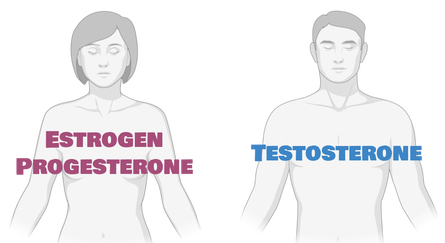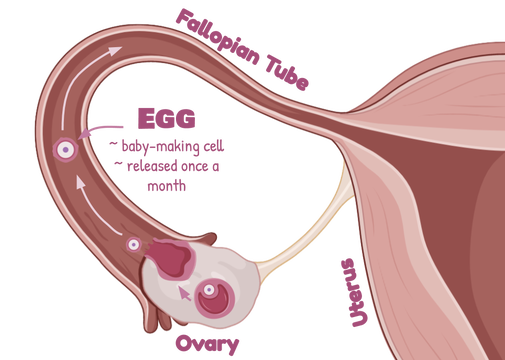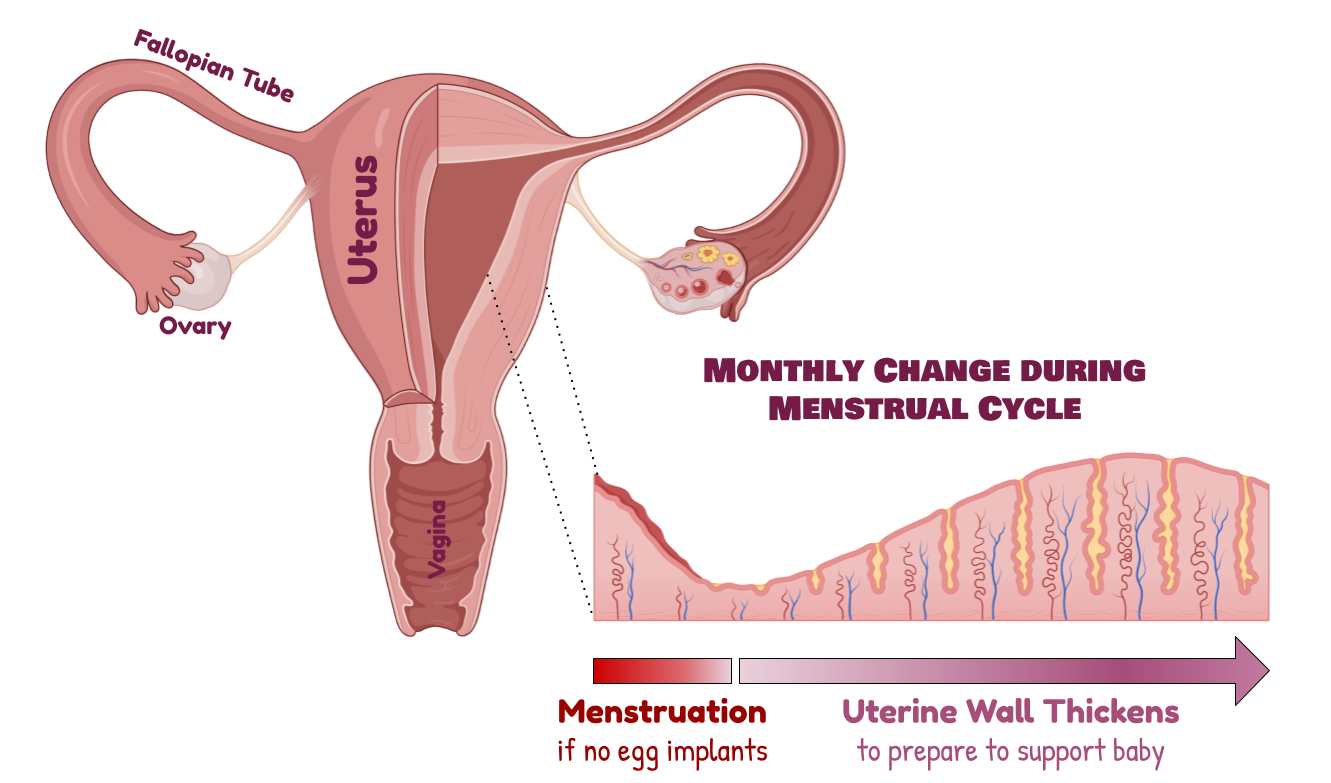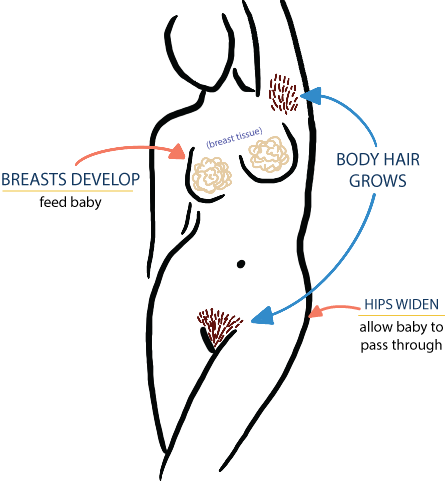hormones, puberty, and reproduction
Estrogen, Progesterone, and Testosterone
As we’ve learned, the body isn’t just focused on keeping you the same. It also changes over time, and this is perhaps most obvious in the context of puberty and reproduction. Estrogen and progesterone are responsible for the development of female sexual characteristics during puberty and are also important regulators of the menstrual cycle, which determines when women can become pregnant. They are both produced by the ovaries, which are only present in women. Testosterone is responsible for the development of male sexual characteristics during puberty and for the production of sperm in reproduction.
You can think of estrogen and progesterone as female hormones and testosterone as a male hormone. But, both women and men have all three, it’s just the level that varies. Estrogen and progesterone are also found in low levels in men, where they are produced mainly by fat tissue and have a few other functions that play a minor role in male physiology. Women also have low levels of testosterone, mainly produced by the adrenal glands and serving other functions.
Sex hormones provide one of the best examples of an advantage of hormones over nervous system control, which is that they can continue to perform the same function over many years without needing constant input from the nervous system, which would require a lot of energy to do the same thing. Puberty and reproduction aren’t just things that can happen over a somewhat longer period of time than nervous system control would provide, they’re things that need to happen slowly to give the body time to develop and change in response to the signal.
What exactly do these changes involve, though, and how are your hormones involved in reproduction? Well, that’s different for those with female anatomy and those with male anatomy, so we’ll talk about them separately.
Sex hormones provide one of the best examples of an advantage of hormones over nervous system control, which is that they can continue to perform the same function over many years without needing constant input from the nervous system, which would require a lot of energy to do the same thing. Puberty and reproduction aren’t just things that can happen over a somewhat longer period of time than nervous system control would provide, they’re things that need to happen slowly to give the body time to develop and change in response to the signal.
What exactly do these changes involve, though, and how are your hormones involved in reproduction? Well, that’s different for those with female anatomy and those with male anatomy, so we’ll talk about them separately.
female development
In those with female anatomy, an increase in estrogen and progesterone starts during puberty, and the levels of these hormones continue to cycle on an approximately monthly basis until menopause, when they gradually drop off. The main role these hormones play is to prepare your body for reproduction. A lot of change needs to go into that! These changes start when your hypothalamus starts to release a hormone called gonadotropin-releasing hormone that causes the release of estrogen and progesterone. Some of the change that estrogen and progesterone then cause include:
- The ovaries develop (mature; they were already there, just not as “grown up”) and start to release eggs, which are the cell type that get together with male sperm to make a baby. We’ll talk more about how that fertilized cell grows into a baby when we talk about reproduction in a later unit. You’re born with all of your eggs, but they don’t mature until they’re released during the monthly ovulation and menstrual cycle.
- The uterus develops, and the menstrual cycle begins. The uterus needs to do a lot of growing from the time you’re born to the time that it can reasonably support a baby. The uterus is where the fertilized egg attaches and grows into a baby. So, it needs to be strong enough to provide a ton of nutrition to a tiny growing baby. But, it would take a lot of energy for the body to just keep it ready all the time. So, instead, every month, the body builds up the lining of the uterus to keep it nice and thick and squishy so that a baby can grow. If no baby grows, that lining is shed. That is when menstruation (periods) occur.
- Secondary female sexual characteristics develop. The two most important female secondary sexual characteristics are development of the breasts and widening of the hips. The breasts are where a baby’s milk comes from, so it makes sense that we need breasts if we’re going to make a baby. The hips widen so that, when a baby is born, it has room to go through the pelvis.
You don’t really need to know the details of female sexual development beyond the two main hormones involved (estrogen and progesterone) and the three main ideas listed above. If you’d like more detail on the process of female development and how hormones change during the menstrual cycle, this video gives a great overview:
male development
Male development is a little less complicated than female development, on account of men don’t actually have to grow a baby inside of them. At the onset of puberty, the testes drop and start to produce sperm. Unlike how women are born with all of their eggs, those with male anatomy constantly make new sperm. That’s because sperm are fairly delicate and very sensitive to temperature changes, and we want to make sure they’re in good condition before they are allowed to go and make a baby. The testes are outside of the body for this same reason: They can protect the sperm by controlling temperature better when they’re kept a little bit away from the body. When it’s cold, the testes are brought closer to the body to keep sperm warm. When it’s hot, the testes move further away from the body to cool sperm down. Testosterone is responsible for ongoing sperm production.
High levels of testosterone also cause the development of secondary male sexual characteristics, such as muscle development, development of body and facial hair, changes in facial structure, and development of the Adam’s apple which causes deepening of the voice.
(You may, at this point, be wondering why we haven’t mentioned one of the more obvious features of the male anatomy: the penis. That’s because it really isn’t all that involved with your hormones or the production of baby-producing sperm cells. It's mainly just a delivery mechanism to get the sperm into the vagina).
Again, you don’t really need to know the details of male sexual development beyond the role of testosterone in sperm development and the role of the testes in temperature regulation of the sperm. If you’d like more detail on how hormones influence male development, this video gives a great overview:
High levels of testosterone also cause the development of secondary male sexual characteristics, such as muscle development, development of body and facial hair, changes in facial structure, and development of the Adam’s apple which causes deepening of the voice.
(You may, at this point, be wondering why we haven’t mentioned one of the more obvious features of the male anatomy: the penis. That’s because it really isn’t all that involved with your hormones or the production of baby-producing sperm cells. It's mainly just a delivery mechanism to get the sperm into the vagina).
Again, you don’t really need to know the details of male sexual development beyond the role of testosterone in sperm development and the role of the testes in temperature regulation of the sperm. If you’d like more detail on how hormones influence male development, this video gives a great overview:
Summary
You should understand:
- That estrogen and progesterone are found in high levels in those with female anatomy and testosterone is found in high levels in those with male anatomy.
- That the following changes occur during female sexual development:
- Ovaries release eggs, which can be fertilized to make a baby. This happens once during the menstrual/ovarian cycle.
- The uterus develops and its walls thicken to support the growth of a baby. The walls thicken each month during the menstrual cycle in preparation for a baby to grow and is then sloughed off during menstruation if no baby implants.
- Breasts develop so that babies will have a food supply, and the hips widen so that the baby can get out of the body and not get stuck on the pelvis.
- Ovaries release eggs, which can be fertilized to make a baby. This happens once during the menstrual/ovarian cycle.
- That sperm (which can fertilize an egg) production begins during male puberty. These are made in the testes, which are located on the external part of the body so that temperature regulation of sperm can occur.
- How the concept of change caused by the endocrine system is important in puberty and reproduction.
Learning Activity
Contributors: Emma Moulton
Some images made with biorender.com
Some images made with biorender.com




